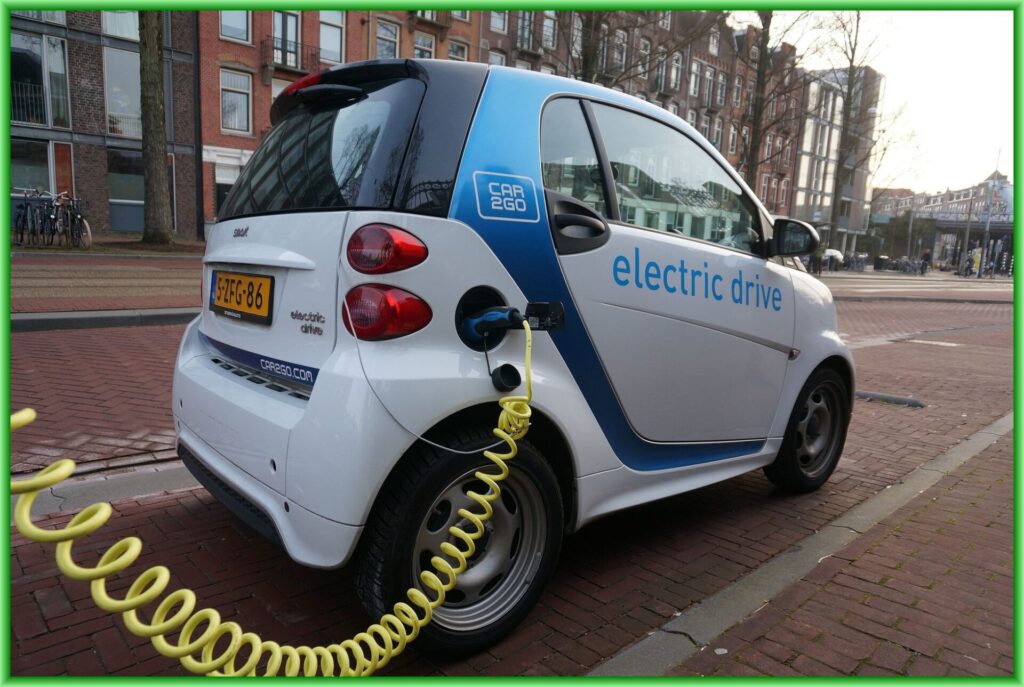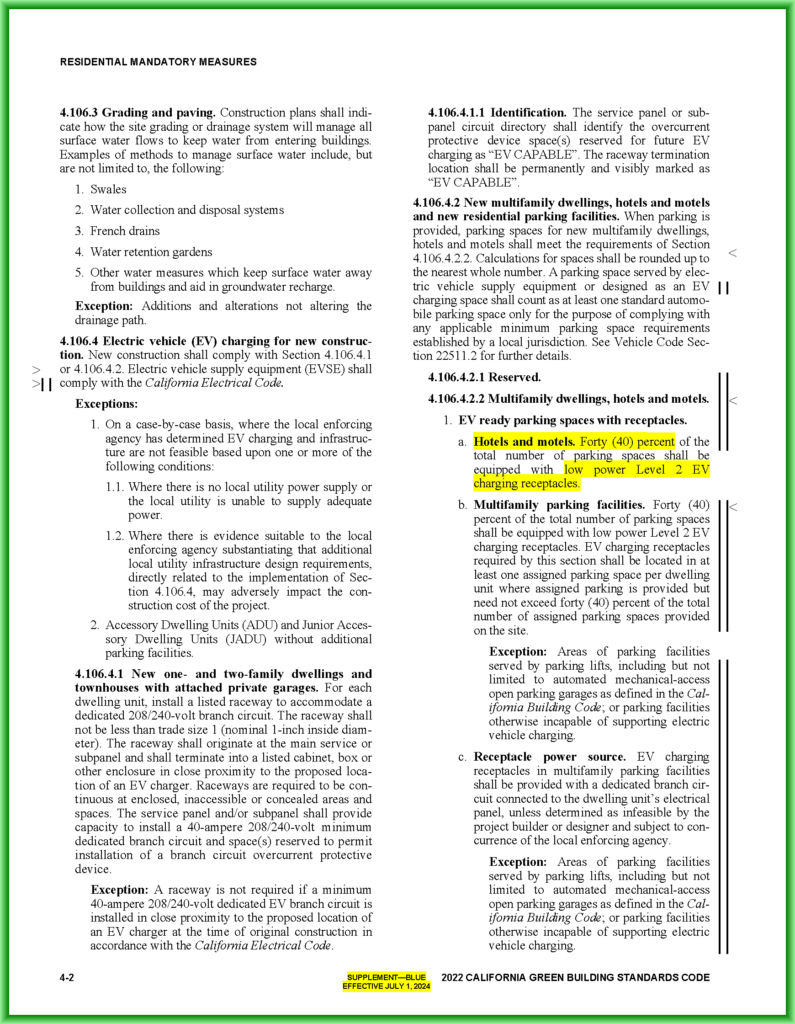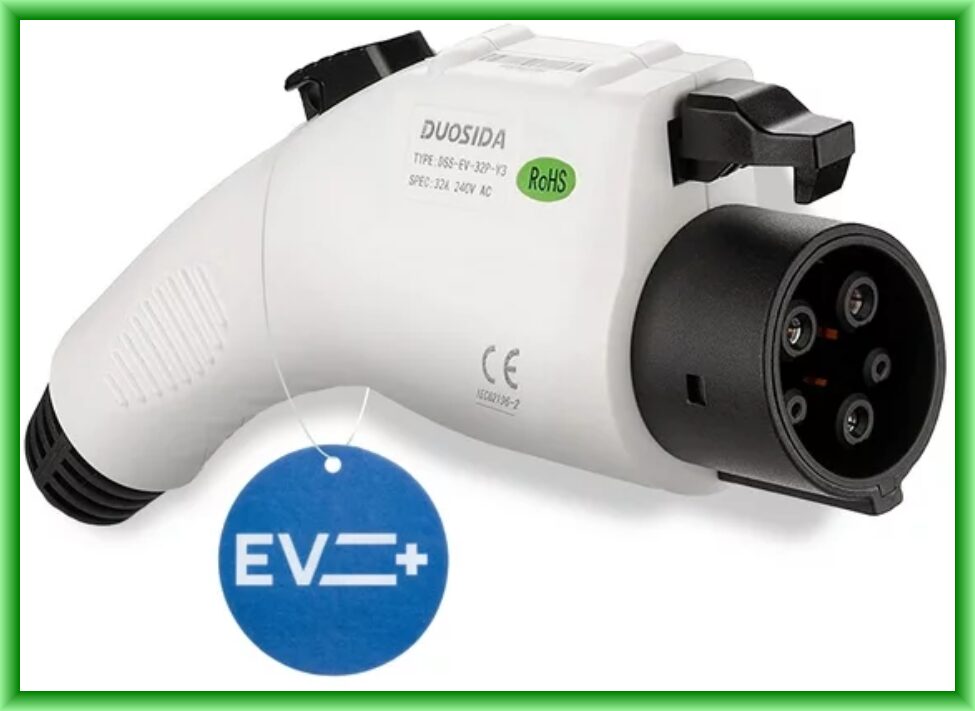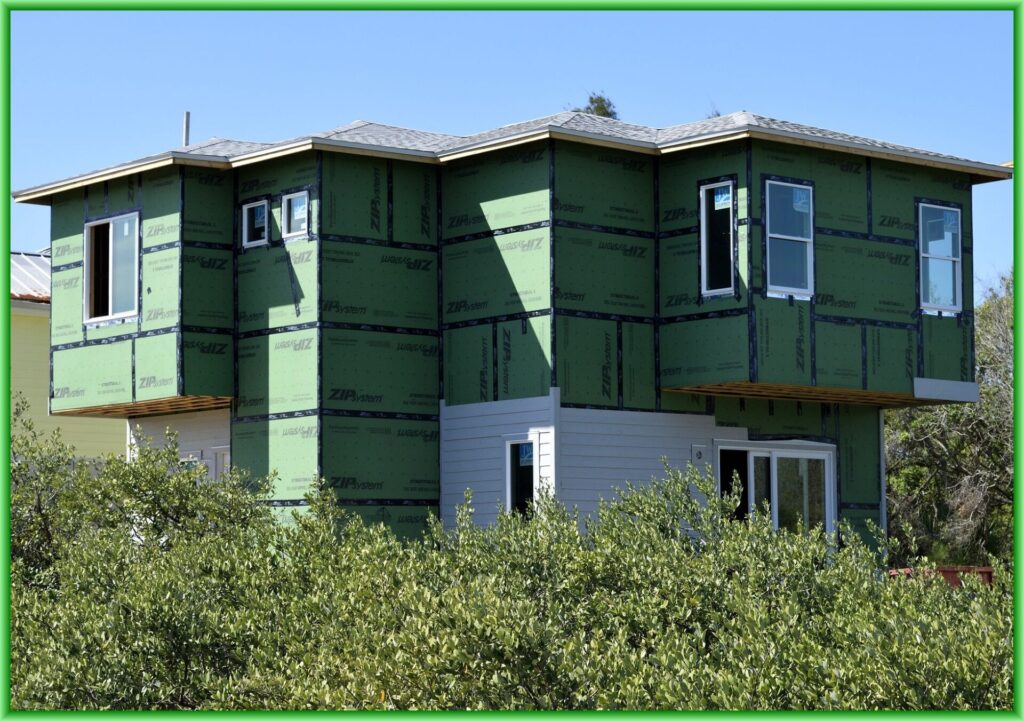2024 CalGreen Residential EV Charging Update
2024 CalGreen Residential EV Charging Update

The 2024 Interim Green Building Standards update has, again, increased the electric vehicle charging requirements for most projects classified as “residential”. These include townhomes, multi-family dwellings, hotels, motels, and multi-family parking facilities.
In general, the 2024 CalGreen residential EV charging updates apply to new construction only. The single exception is for additions and alterations to existing parking facilities serving existing multi-family buildings.
The revised sections of the the CalGreen Code go into effect as of July 1, 2024.
You can read the full text of all the 2024 CalGreen Code Interim Supplement updates here.
The EV Charger Changes
We will limit this article to the 2024 CalGreen residential EV charging updates only. For details on the base code, or definitions of terminology (such as EV Ready, EV Capable, etc.) see our previous articles here and here. Also note that we will not comment on minor changes that do not have a direct impact on design or cost issues.
The good news is that there are no changes to the requirements for one and two family dwellings and townhomes with attached garages.
The bad news is that new multi-family dwellings, hotels, motels and new residential parking facilities are hit with a huge increase in the EV requirements. These changes will have tremendous cost impacts on larger projects that will impact the design, construction, and long term operation of these facilities. While hyperbole is common on many internet blogs, read on to find out why this is not an exaggeration.
Hotels and Motels EV Code Changes
Revised paragraph CG 4.106.4.2.2.1.a. now requires forty percent (!) of the total number of parking spaces be equipped with low power Level 2 EV charging receptacles. Yes, you read that correctly. Forty percent of all the required new hotel and motel parking spaces must be provide with operational electric vehicle chargers.

Level 2 EV Charging Receptacles
This is a whopping increase from the ten percent that was in the original 2022 Green Building Standards Code.
To put this into perspective, a small on hundred unit motel with 100 parking spaces would require 40 level 2 EVSE charge stations. At 30 amps of 208 volt services that’s a whopping 1200 amps of power required!
A recent 100 unit hotel we worked on had a total electrical demand (without EV chargers included) of 1600 amps for the entire hotel power supply. These new requirements almost double the power, and the associated electrical infrastructure required for such a facility.
To clarify, the updated code added a definition for a “low power Level 2 EV charger”. It reads as follows:
CG Supplement, Effective July 1, 2024: Level 2 Electric Vehicle (EV) Charger. A 208/240-volt 30-ampere minimum electric vehicle charger connected to the premises electrical system capable of charging electric vehicles.
Those with a wary eye may have noticed a discrepancy in the terminology above. The new code refers to “level 2 charging receptacles“. The new definition refers to “level 2 EV charger“.
The term “charging receptacle” is not defined in either the 2022 code or the July 1st update. Unfortunately this is one of the many unanswered questions that the CalGreen Code EV charging requirements raises. On one hand, this section of the code did not use the term EVSE, which would have required a 40 amp service. Common sense would suggest the California Energy Commission was, therefore, referring to the 30 amp circuit noted in the new definition. This is one of the many items that you should clarify early in the design of a project with the local building department, and immortalize in writing.
Yet, the new requirement for hotels and motels don’t stop here…`
In addition to the above, CG 4.106.4.2.2.2.a now requires ten percent of the parking spaces to be equipped with Level 2 EVSE chargers. Also, at least 50% of these chargers must be equipped with J1772 connectors.

A “level 2 EVSE” charger is defined in the code as:
The 208/240-volt 40-ampere branch circuit, and the electric vehicle charging connectors, attachment plugs and all other fittings, devices, power outlets or apparatus installed specifically for the purpose of transferring energy between the premises wiring and the electric vehicle.
A J1772 connector is a charger plug that is typically used on all non-Tesla vehicle chargers.

A typical J1772 Charge Plug
Note that CG CG 4.106.4.2.2.1 Exception excludes public housing hotels and motels from the Level 2 EVSE charger requirements.
The new code changes have made matters even worse by now dictating parking space dimensions for spaces equipped with EV charger equipment. I won’t go into detail here but I can tell you that this will have an impact on parking lot layouts. You can review these requirements here.
Multifamily EV Code Changes

The 2024 CalGreen residential EV charging updates revise paragraph CG 4.106.4.2.2.b.. It now requires forty percent (!) of the total number of parking spaces be equipped with low power Level 2 EV charging receptacles. The EV charging receptacles required by this section shall be located in at least one assigned parking space per dwelling unit where assigned parking is provided but need not exceed forty (40) percent of the total number of assigned parking spaces provided on the site.
Under the original 2022 code this section was divided into projects with less than 20 dwelling units and more than 20 dwelling units. Those distinctions are no longer there, and the new requirements apply to all multi-family dwellings.
Note that the CalGreen Code does not define “multifamily dwelling”. In other sections of this code there is reference to “5 or more dwelling units”. However, that is not the case here. It must be presumed that the new requirement applies to a dwelling unit of three or more dwellings, as defined in Volume 1 of the California Building Code.
As if the forty percent charger requirement were not enough of a financial hit, there is even a more ominous requirement in the new update. And once again I am not exaggerating.
CG CG 4.106.4.2.2.c., page 4-2, now defines where the power source comes from. It is no longer at the discretion of the owner and design team, where economical choices can be made. Instead, the code reads:
c. Receptacle power source. EV charging receptacles in multifamily parking facilities shall be provided with a dedicated branch circuit connected to the dwelling unit’s electrical panel, unless determined as infeasible by the project builder or designer and subject to concurrence of the local enforcing agency.
For those that may not understand the significance, this means that a total of 40 percent of the projects dwelling units must now be provided with an electrical service more than double what would normally be required! So now the project has to double the power service to the site and double the power service to 40 percent of the dwelling units. In addition, now conduit and cable must be extended from each dwelling unit to their respective charger!
And, of course there is more…
CG 4.106.4.2.2.2.b, page 4-3, requires ten percent of the total number of parking spaces to be equipped with Level 2 EVSE chargers. Also, at least 50% of these chargers must be equipped with J1772 connectors.
As noted above, the new code also dictates parking space dimensions for spaces equipped with EV charger equipment. This is sure to create confusion with parking space requirements noted elsewhere in the code. I won’t go into detail here but I can tell you that this will have an impact on parking lot layouts. You can review these requirements here.
Note also that CG 4.106.4.3, page 4-3, also has new requirements for additions and alterations to existing multifamily parking facilities. Ten percent of the total number of parking spaces added or altered shall be EV capable spaces to support future Level 2 electric vehicle supply equipment. The service panel or subpanel circuit directory shall identify the overcurrent protective device space(s) reserved for future EV charging purposes as “EV CAPABLE.”
In all of the above cases the code notes that uneven numbers are to be rounded up to determine the number of EV chargers required. For example, a nine unit complex will require four low power Level 2 EV charging receptacles and one Level 2 EVSE charger.
A Personal Note

I believe the cost and long term operational impacts of these requirements are extreme enough that hotel and multi-family developers may choose not to build in California due to the extreme construction and long term operational requirements of the massive new EV charger systems required.
My professional opinion is that the California Energy Commission are a group of insane individuals who have given zero consideration for the serious impact of these changes on real world projects. Currently there is zero over-sight to this organization which is the real root of the problem.
In addition, it is the mission of the California Building Standards Commission to “create practical and usable building standards and administrative regulations that enforce those standards.” They have fallen short of their stated mission in this case as there is nothing “practical” about these sudden and massive cost impacts to these projects.
While there may be some need in the future for this level of charging capability, that need is a long way off. Penalizing new construction today for some possible need in the future goes far beyond the intent behind the mission of the California Building Code. It’s time for the politicians in this state to rein in the California Energy Commission. At the same time, the California Building Standards Commission needs to uphold their mission of ensuring “practical” building codes.
Those who have worked with me, or have read information on my website, know that I am always happy to share my knowledge on the CalGreen Code. However, the EV charging requirements have created such a flood of information requests, that it is negatively affecting my business. I can no longer accept inquiries on the EV charging requirements of the CalGreen Code. Nor do I wish to act as a consultant on this subject.
If you have questions on this code I suggest you try calling the California Energy Commission, Building Energy Efficiency Standards, at 800-772-3300. Or you can email them at title24@energy.ca.gov.
Gary Welch
ICC Certified CalGreen Special Inspector/Plans Examiner


Gary Welch has over 35 years experience in the field of sustainable building design. He is the CEO of CalGreen Energy Services. Gary is an ICC Certified CalGreen Special Inspector and Plans Examiner.
